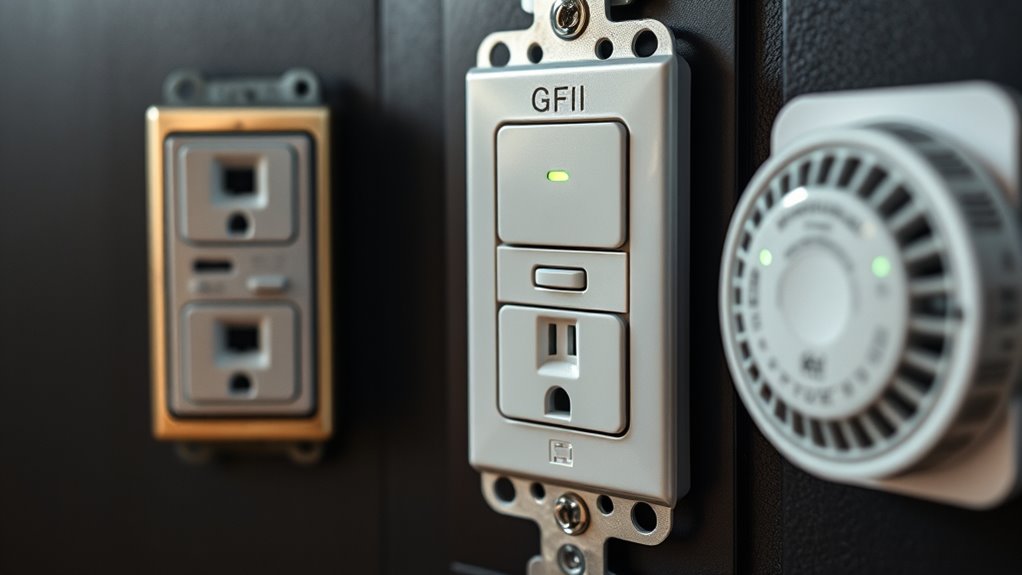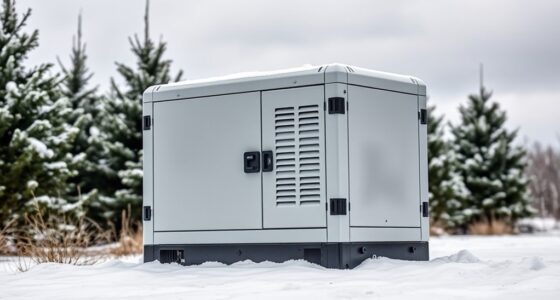AFCIs and GFCIs work together by detecting different types of faults—arc faults and ground faults—to prevent fires and shocks. Installing both on the same circuit is allowed if properly wired, and each device trips independently when faults occur. They don’t interfere with each other, but limitations like false trips or missed faults can happen. Staying aware of their functions helps keep your home safe—if you want more details, there’s plenty more to learn.
Key Takeaways
- AFCIs detect arc faults to prevent fires, while GFCIs sense ground faults to prevent shocks, each with distinct detection mechanisms.
- Installing AFCIs and GFCIs on the same circuit is safe if properly wired and following manufacturer instructions.
- During faults, AFCIs trip from arc faults and GFCIs trip from ground faults, often independently, providing layered protection.
- Regular testing of both devices ensures proper function; false trips or failure to trip indicate maintenance is needed.
- Proper maintenance and timely inspection are crucial to ensure both AFCIs and GFCIs operate effectively and safely.
How Do AFCIs and GFCIs Detect Electrical Issues?
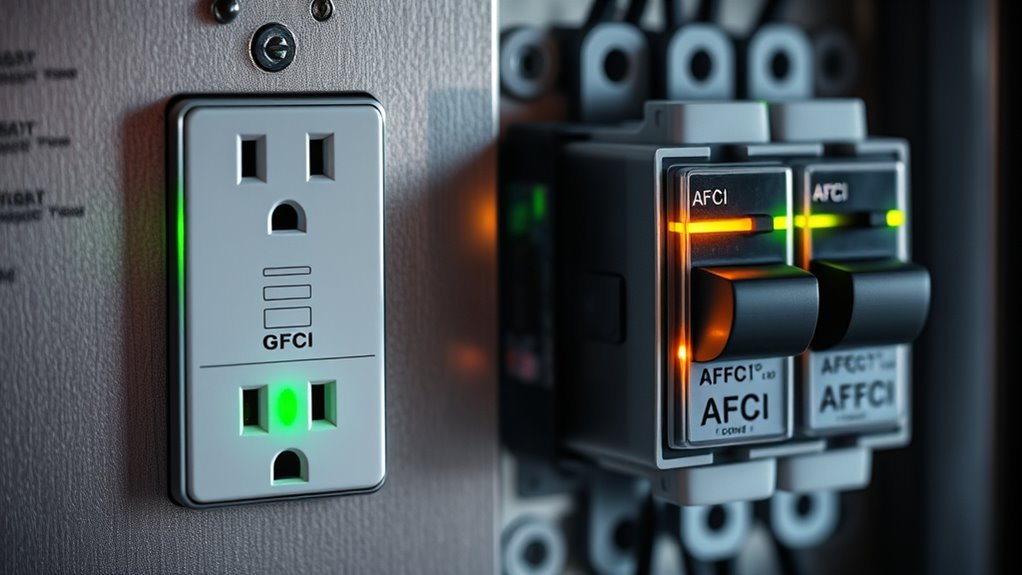
AFCIs and GFCIs detect electrical issues by monitoring specific patterns of electrical current. They constantly analyze the flow to identify abnormalities. AFCIs focus on electrical fault detection related to arc faults, which can cause fires. They recognize irregular current patterns typical of arcing, then trip the circuit to prevent damage. GFCIs, on the other hand, detect ground faults by sensing differences between hot and neutral wires. When they notice unequal currents, they trip quickly, protecting against electric shock. Both devices work together with proper circuit breaker coordination to ensure safety without unnecessary trips. Their precise monitoring helps prevent hazards caused by wiring issues, overloads, or faults. By continuously observing current patterns, AFCIs and GFCIs provide critical electrical fault detection, safeguarding your home efficiently. Understanding electrical safety devices is essential for maintaining a secure electrical system.
What Are the Main Differences Between AFCIs and GFCIs?
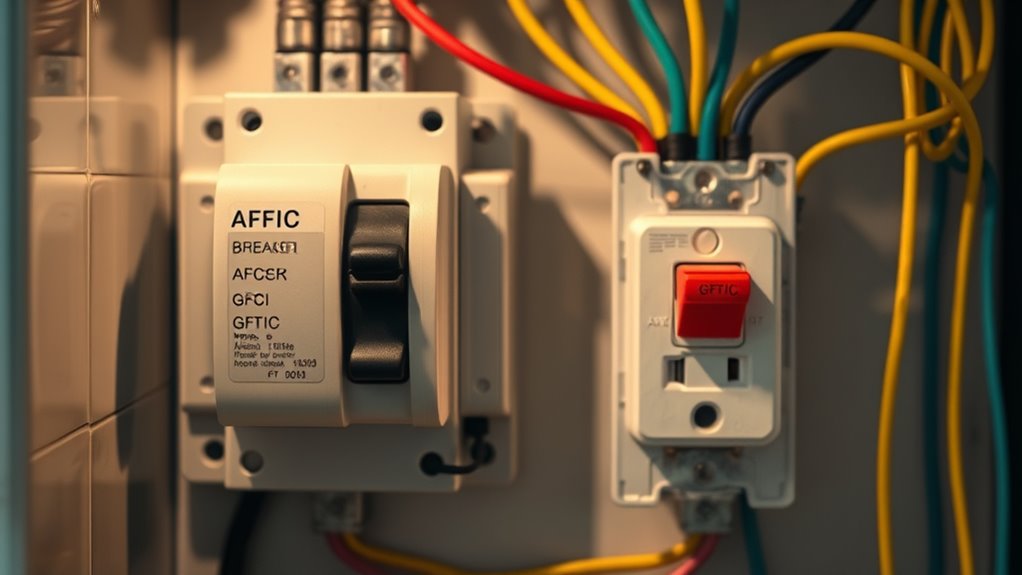
The main differences between AFCIs and GFCIs lie in what they detect and how they protect your home. AFCIs focus on preventing fires caused by arc faults, while GFCIs protect against ground faults that could cause electric shocks. Both enhance circuit protection and electrical safety but serve distinct roles. Consider this comparison:
| Feature | AFCI | GFCI |
|---|---|---|
| Detects | Arc faults | Ground faults |
| Protects against | Fire hazards | Electric shocks |
| Location | Living areas, bedrooms | Bathrooms, kitchens |
Understanding these differences helps you choose the right device for each circuit, ensuring comprehensive electrical safety and peace of mind. An additional benefit of AFCIs is their ability to detect potential wiring issues, further reducing fire risks.
Can an AFCI and GFCI Be Installed on the Same Circuit?

Can you install an AFCI and GFCI on the same circuit? Yes, but you need to consider circuit compatibility and device coordination. Typically, code permits installing both devices on the same circuit if they are properly wired and designated for different points of protection. Usually, an AFCI protects the branch circuit wiring, while a GFCI protects receptacles or specific outlets. To ensure proper device coordination, you’ll want to install the AFCI upstream from the GFCI so that the AFCI trips first in case of a fault. Keep in mind that combining these devices on one circuit doesn’t mean they’ll interfere with each other, but it’s essential to follow manufacturer instructions and electrical codes to ensure safe and effective protection. Additionally, understanding the security zone info can help clarify the importance of proper circuit protection in safeguarding your home.
How Do These Devices Interact During a Fault?

When a fault occurs on a circuit protected by both an AFCI and a GFCI, these devices respond differently but work together to enhance safety. If an arc fault sparks, the AFCI detects the irregular arc pattern and quickly trips, stopping the fire risk. Meanwhile, if a ground fault causes current to leak, the GFCI senses the imbalance and trips to prevent shock. To envision this, consider the following:
| Fault Type | Device Response |
|---|---|
| Arc Fault | AFCI trips due to irregular arcs |
| Ground Fault | GFCI trips from current imbalance |
| Both Occur | Both devices may trip independently |
| No Fault Detected | Both devices stay active |
Together, they provide layered protection, catching different fault types for comprehensive safety.
Are There Limitations to Their Protective Capabilities?

Although AFCIs and GFCIs considerably enhance electrical safety, they do have limitations you should know. One key limitation is false tripping, which occurs when these devices disconnect power without a real fault, disrupting your use of electrical appliances. False tripping can happen due to wiring issues, electromagnetic interference, or device sensitivity settings. Additionally, AFCIs may not detect all arc faults, especially low-level or intermittent ones, leaving some risks unaddressed. GFCIs can’t prevent overcurrent conditions or protect against other electrical hazards like short circuits or overloads. Understanding these limitations means you won’t rely solely on these devices for complete safety. Proper installation, regular testing, and awareness of their boundaries help maximize their protective capabilities while minimizing false trips. The effectiveness of these devices can also be influenced by their technology and design, which determine how well they detect and respond to faults.
What Are Common Scenarios Where Both Devices Are Needed?
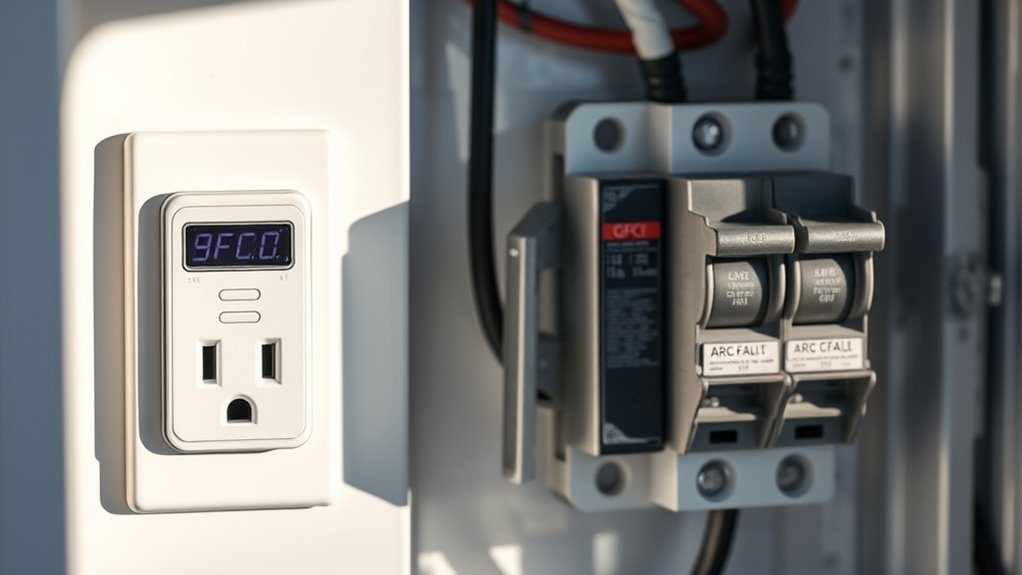
Many situations in your home or workplace call for both AFCIs and GFCIs to work together, ensuring extensive protection against different electrical hazards. For example, in kitchens and bathrooms, GFCIs protect against ground faults that could cause electrocution, especially near water sources. AFCIs are essential in living rooms and bedrooms to detect arc faults that could ignite fires from damaged wiring or loose connections. These devices often work in tandem when you have circuits with both risk types. Ground faults, like a faulty appliance causing current leakage, require GFCI protection. Meanwhile, arc faults, which create dangerous sparks, need AFCI detection. Using both devices together helps minimize the risk of electrical shock and fires from different hazards, providing thorough safety coverage throughout your space. Understanding the differences between AFCIs and GFCIs is crucial for proper circuit protection.
How Do Code Requirements Influence Their Use Together?

Code requirements play a vital role in guaranteeing that AFCIs and GFCIs are used together correctly and effectively. Electrical codes specify how circuit design must incorporate these devices to maximize safety. For example, the National Electrical Code (NEC) mandates where AFCIs and GFCIs are required, influencing how circuits are planned and installed. These requirements help determine the placement of devices within circuits, ensuring that both protective measures work together without conflict. Proper circuit design, guided by electrical codes, ensures that AFCIs and GFCIs complement each other, reducing risks of electrical fires and shocks. Additionally, automation’s role in business intelligence can facilitate the implementation and compliance with these code standards through automated checks and updates. Following these code mandates guarantees compliance, safety, and ideal device operation, emphasizing the importance of adhering to all relevant regulations during installation.
What Should Homeowners Know About Maintaining These Safety Devices?
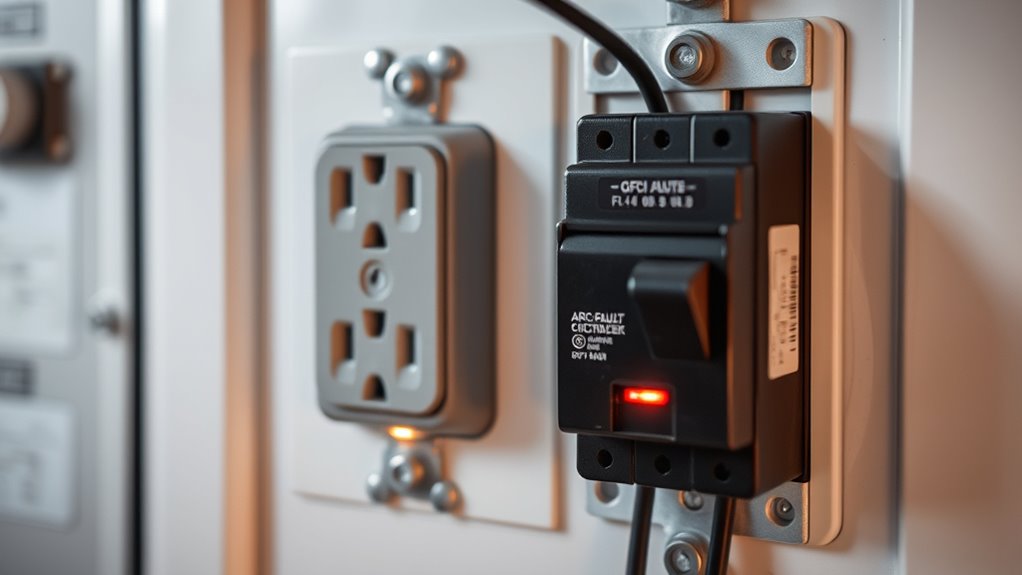
To keep your safety devices working properly, you should regularly test them to make certain they trip correctly. Watch for warning signs like frequent nuisance trips or visible damage, which may indicate a problem. Consider having a professional inspect and maintain your devices periodically to prevent potential hazards.
Regular Testing Procedures
How often should you test your arc-fault and GFCI devices to make certain they’re functioning properly? It’s recommended to test these safety devices monthly. For GFCIs, press the test button and confirm the device trips, cutting off power. Then, press the reset button to restore power. During ground fault testing, ensure the GFCI detects a ground fault and trips as it should. For arc fault inspection, use a specialized tester or consult a professional if you notice any irregularities or after a power surge. Regular testing helps identify issues early, maintaining safety and preventing electrical fires. Always follow the manufacturer’s instructions for testing procedures and replace units that fail to trip or reset properly. Staying proactive ensures your safety devices function effectively when needed. Additionally, with the rise in AI-driven security systems, ensuring your safety devices are properly maintained becomes even more critical.
Recognizing Warning Signs
Keeping an eye out for warning signs is essential to guarantee your arc-fault and GFCI devices stay reliable. If you notice frequent tripping of your circuit breakers or GFCIs, it might indicate circuit overloads or wiring faults. Flickering lights or outlets that feel warm or buzz could signal underlying wiring issues needing attention. Persistent electrical shocks or sparks when plugging in devices are serious red flags. Unusual burning smells or scorch marks near outlets point to potential wiring faults that compromise safety. Ignoring these signs can lead to electrical fires or damage. Regularly inspect your outlets and cords, and don’t dismiss signs of malfunction. Recognizing these warning signs early helps prevent hazards and ensures your safety devices function properly when needed. Additionally, staying informed about electrical safety can improve your overall lifestyle by reducing the risk of accidents and promoting a safer home environment.
Professional Maintenance Tips
Regularly maintaining your arc-fault and GFCI devices helps guarantee they function properly when you need them most. Start by inspecting the devices for any signs of damage, such as cracks or corrosion. Test ground fault detection features monthly by pressing the test button—if it doesn’t trip, replace the device. For arc detection, ensure the device’s indicator lights are functioning correctly; a malfunctioning light could mean it’s not sensing arc faults properly. Keep the surrounding area clean and dry to prevent false trips. Always follow manufacturer instructions for maintenance and replacement. If a device trips frequently or shows signs of wear, don’t hesitate to call a professional electrician. Proper maintenance ensures these safety devices reliably protect your home from ground faults and arc faults. Additionally, regularly checking for proper functionality helps ensure these devices continue to work effectively over time.
Frequently Asked Questions
Can AFCIS and GFCIS Be Tested Together Effectively?
Yes, you can test AFCIs and GFCIs together effectively by ensuring device compatibility and following proper testing procedures. First, verify that both devices are installed correctly and compatible with each other. Then, use the designated test buttons on each device to check their functionality. Regular testing helps confirm they’re working properly and can protect against electrical faults. Always follow manufacturer instructions for accurate testing and safety.
Do Different Brands of AFCIS and GFCIS Interfere With Each Other?
Different brands of AFCIs and GFCIs generally don’t interfere with each other if they meet proper electrical standards and are compatible. You can think of them working like a team, each following a shared set of rules to ensure safety. When selecting devices, check brand compatibility and adherence to electrical standards. This way, you guarantee your system functions smoothly, with all components working together without conflict or interference.
Are There Specific Wiring Practices to Optimize Their Combined Use?
You should follow proper wiring configurations and installation guidelines to optimize the combined use of AFCIs and GFCIs. Confirm these devices are installed on separate circuits when necessary, and avoid daisy-chaining them together. Use dedicated circuits if possible, and adhere to manufacturer instructions for wiring. Proper grounding, avoiding shared neutral wires, and consulting local electrical codes will help prevent interference and ensure both devices function effectively together.
How Often Should Homeowners Have These Devices Inspected or Replaced?
Think of your electrical safety devices as guards that need regular checkups to stay alert. You should have a professional inspection at least once every 3 to 5 years, depending on usage and environment. Replace any GFCI or arc-fault circuit interrupters if they show signs of wear or malfunction. Following a consistent maintenance schedule helps guarantee your home’s electrical system remains safe and reliable.
Are There Advanced Models That Integrate Both AFCI and GFCI Functions?
Yes, there are advanced models that integrate both AFCI and GFCI functions. These integrated device designs combine arc-fault and ground-fault protection into a single unit, making installation compatibility easier and saving space. You’ll find these devices suitable for modern electrical setups, providing thorough safety. When upgrading your system, make certain the integrated device meets local codes and is compatible with your existing wiring for effective and reliable protection.
Conclusion
Understanding how AFCIs and GFCIs work, recognizing their differences, and knowing when to install them helps you protect your home effectively. By knowing how they detect faults, interact during issues, and comply with code requirements, you can make informed safety choices. Staying aware of their limitations and maintenance needs keeps your electrical system reliable. Ultimately, integrating these devices thoughtfully guarantees safety, peace of mind, and a secure environment for you and your loved ones.
